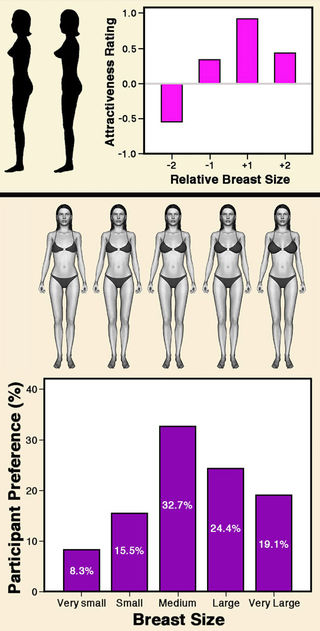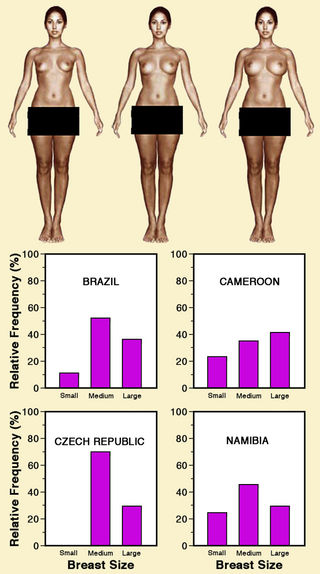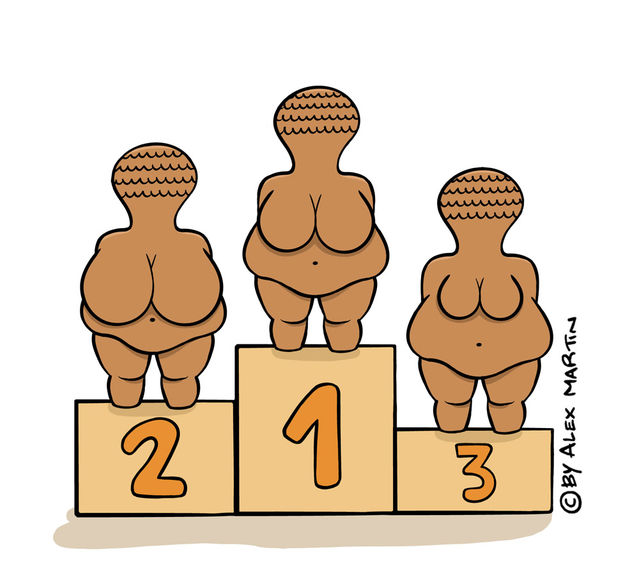Across cultures, men do not consistently prefer large breasts.
Supposedly, consistent male preferences for a particular breast size feed claims that they reflect evolutionary adaptation.
To make this plausible, it must be shown that reported attractive features provide cues to women’s potential reproductive capacity or health. But any preferences may be largely or exclusively culturally determined, perhaps reflecting particular notions of female beauty peddled by Western media.
Do men prefer large breasts?
Since the 1960s, many studies have assessed the attractiveness of women’s breasts, notably regarding the size. One early contribution by Jerry Wiggins and colleagues (1968) tested men’s preferences for breasts, buttocks, and legs using simple, nude female silhouettes.
Ninety-five male undergraduates rated paired images with different sizes of those body regions. The main aim was to identify personality traits associated with preferences, but some interesting baseline information emerged. Although men rated large breasts as more attractive than small ones, moderate breast size was preferred over the largest presented.

Top: Example of test silhouettes used by Wiggins et al. (1968) and a plot of relative scores for the attractiveness of breasts in 4 categories (-2 = well below average; -1 = below average; (1 = above average; 2 = well above average). Bottom: Test silhouettes used by Swami & Tovée (2013) with a histogram showing preferences for five breast size categories.Source: Top: Combined image adapted from a figure and data in Wiggins et al. (1968). Bottom: Combined image adapted from two figures in Swami & Tovée (2013).
Subsequently, published attractiveness ratings for breast size yielded conflicting findings, with preferences for large, medium, or even small breasts reported. Overall, however, men predominantly rated medium-sized breasts highest.
A prime example is a 2013 paper by Viren Swami and Martin Tovée, reporting on a sophisticated study using rotating 3D test models, which yielded ratings close to the original findings of Wiggins and colleagues. Choosing between five different breast size categories, a third of men rated medium as most attractive. Only a quarter preferred large breasts and just one in 10 preferred very large breasts.article continues after advertisement
To identify social influences, Swami and Tovée studied British white men in a London community. They found that preferences for larger breasts were significantly associated with greater tendencies towards “benevolent sexism,” objectification of women, and hostility towards them.
The all-important cross-cultural perspective
Only cross-cultural studies can reveal responses that are consistent regardless of social norms and may perhaps have an evolutionary foundation. A 2010 paper by Barnaby Dixson and colleagues explicitly addressed this key issue of variation across cultures. Using a questionnaire, preferences for women’s breasts in test images were assessed for over 200 men in New Zealand, Samoa, and Papua New Guinea.
One clear finding was that men in Papua New Guinea showed a greater preference for larger breasts than New Zealanders, while Samoan men were intermediate. Intriguingly, preferences differed between unmarried and married men. In New Zealand, bachelors predominantly preferred a medium size while married men favored large breasts.
Differences between cultures also emerged. Although Samoan men showed a distinction between unmarried and married men like New Zealanders, they more strongly preferred larger breasts overall. Contrastingly, unmarried and married men differed little in Papua New Guinea; both predominantly preferred large breasts.

Figure showing men’s responses to women’s breasts in three different populations: New Zealand, Samoa, and Papua New Guinea. Left: Test images of a female torso modified to have three different breast sizes (small, medium, large). The skin color has been adjusted to reflect local average conditions in the three populations. Right: Histograms showing breast size preferences shown by unmarried and married men in each test population. Note that the pattern for Papua New Guinea is markedly different from that seen in New Zealand and Samoa.
Taking a broader approach, a 2017 paper by Jan Havlíček and colleagues assessed men’s preferences for both the size and shape of women’s breasts in four cultures—Brazil, Cameroon, the Czech Republic, and Namibia. Breast firmness declines with age and successive births, so the authors proposed that—whereas breast size in young women indicates potential fertility—breast firmness might indicate residual fertility thereafter. They hypothesized that, across cultures, men would be expected to show preferences for both breast size and firmness (which affects shape).
Tests conducted with male raters used two sets of images, one with differing breast size and the other with various degrees of breast firmness. Although size preferences varied, most raters preferred medium breasts, with large following, providing cross-cultural confirmation that men generally prefer breasts of intermediate size.
Across all four cultures, Havlíček and colleagues identified a consistent preference for firm breasts, supporting the notion that shape indicates residual fertility.

Figure showing men’s responses to women’s breasts in four different populations: Brazil, Cameroon, Czech Republic, Namibia. Top: Test images of a female body modified to have three different breast sizes (small, medium, large), based on originals from Dixson and colleagues. Right: Histograms showing breast size preferences shown by men in each test population. Note that there is a predominant tendency towards a preference for medium-sized breasts, although Cameroon is an exception with large breasts rated higher.Source: Image combined and adapted from two figures in Havlíček et al. (2017).






